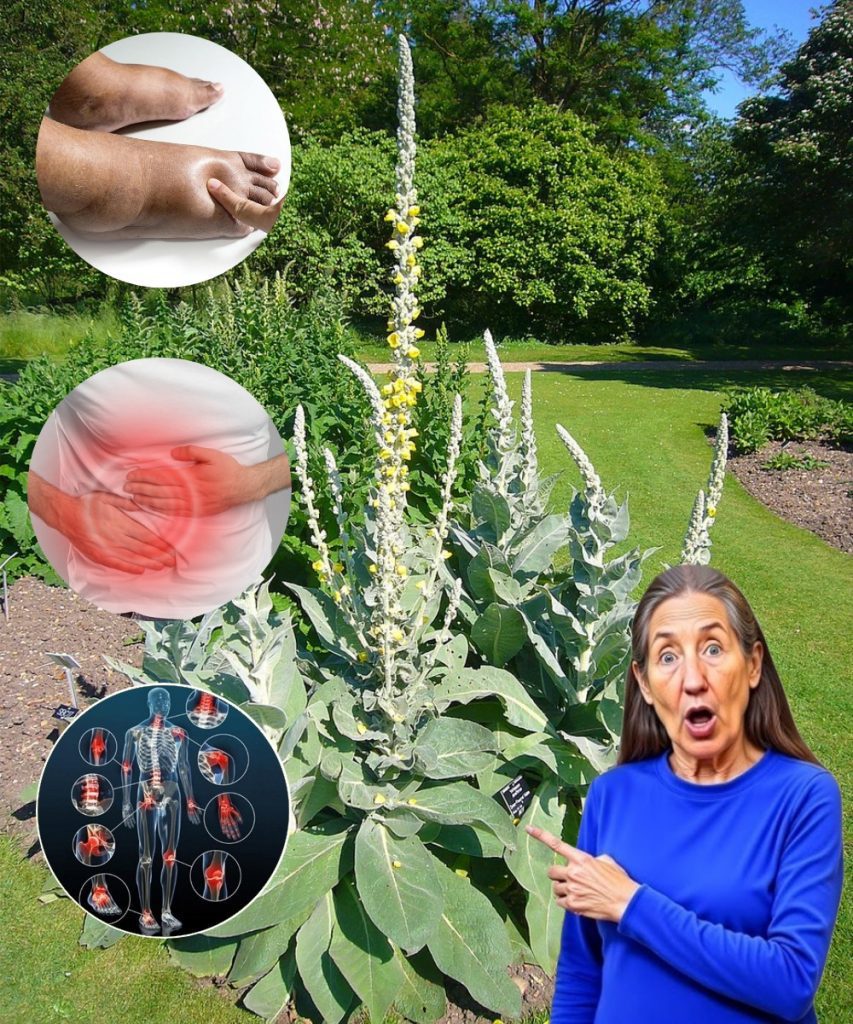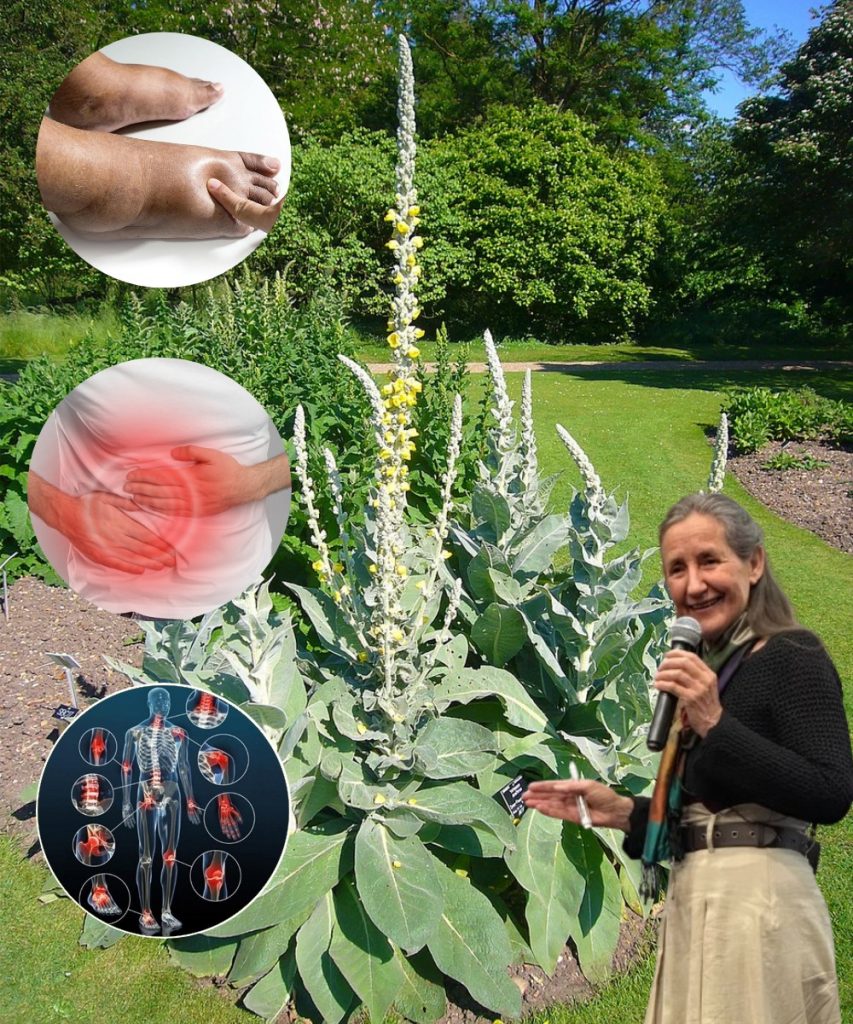What if a plant growing wild in your backyard could soothe your lungs, heal your skin, and even light your way in the dark? Common Mullein (Verbascum thapsus), with its towering golden spikes and soft, velvety leaves, is far more than a roadside weed. This biennial herb, native to Europe, Asia, and North Africa, has been a cornerstone of traditional medicine and practical innovation for centuries. From easing respiratory distress to nurturing ecosystems, mullein’s versatility is nothing short of extraordinary. Ready to uncover the hidden potential of this herbal marvel? Dive into these 10 life-changing benefits and practical uses that will keep you captivated and inspired to embrace mullein in your wellness journey.

🫁 1. Revolutionizes Respiratory Health
Struggling with a stubborn cough or chest congestion? Mullein is a time-honored remedy for respiratory woes. Its leaves and flowers are rich in mucilage and saponins, acting as a natural expectorant to loosen mucus and clear airways. Whether you’re battling bronchitis, asthma, or a nagging cold, mullein’s anti-inflammatory properties soothe irritated tissues, making breathing easier and more comfortable.
How to Use It: Brew a soothing mullein tea by steeping 1-2 teaspoons of dried leaves or flowers in hot water for 10-15 minutes. Strain thoroughly to remove fine hairs, and sip 2-3 cups daily to ease coughs and congestion. For a more potent option, try a mullein tincture for targeted relief.
👂 2. Soothes Ear Infections Naturally
Earaches can be debilitating, especially for children, but mullein offers a gentle, effective solution. Mullein flower oil, infused with antimicrobial and anti-inflammatory compounds like verbascoside, reduces pain and fights infection. Its calming properties make it a trusted remedy for otitis media and other ear discomforts.
How to Use It: Warm a few drops of mullein-infused oil (test the temperature on your wrist) and apply 2-3 drops to the affected ear. Use only under guidance from a healthcare provider, especially if there’s a risk of eardrum rupture. This remedy is safe for short-term use and can provide rapid relief.
🩹 3. Accelerates Skin Healing
Mullein’s emollient and astringent qualities make it a powerhouse for skin care. Whether you’re dealing with burns, cuts, bruises, or eczema, mullein’s anti-inflammatory and antimicrobial properties promote faster healing and soothe irritation. Its soft leaves have been used for centuries as natural bandages, protecting and nourishing damaged skin.
How to Use It: Apply mullein-infused oil directly to minor wounds or irritated skin. For deeper healing, create a poultice by mashing fresh or boiled leaves and applying them to the affected area. Regular use can improve skin texture and reduce inflammation.
🔥 4. Reduces Inflammation and Pain
Chronic inflammation and pain can disrupt your quality of life, but mullein’s bioactive compounds, including flavonoids and verbascoside, offer natural relief. These antioxidants combat inflammation, easing joint pain, muscle aches, and even headaches. Mullein’s mild analgesic properties make it a versatile ally for everyday discomfort.
How to Use It: Sip mullein tea or take a tincture to address internal inflammation. For localized pain, apply a mullein poultice or oil to sore joints or muscles. Consistent use can support long-term comfort and mobility.
🦠 5. Fights Infections with Antimicrobial Power
Mullein’s antiviral and antibacterial properties make it a formidable opponent against infections. Research suggests it can inhibit bacteria like Staphylococcus aureus and Escherichia coli, as well as viruses like influenza. This makes mullein a valuable tool for boosting immunity during cold and flu season.
How to Use It: Drink mullein tea regularly to support your immune system. For topical infections, apply mullein oil to affected areas. Always consult a healthcare provider for serious infections to ensure proper treatment.
🍵 6. Supports Digestive Wellness
Mullein isn’t just for lungs and skin—it’s also a friend to your gut. Its anti-inflammatory and soothing properties help calm digestive issues like diarrhea, constipation, and hemorrhoids. By reducing inflammation in the gut lining, mullein promotes smoother digestion and overall comfort.
How to Use It: Sip a cup of mullein tea after meals to ease digestive discomfort. For hemorrhoid relief, apply mullein-infused oil topically to reduce swelling and irritation. This gentle remedy can restore balance to your digestive system.
🕯️ 7. Illuminates with Historical Practicality
Mullein’s utility extends beyond medicine into practical, everyday applications. In ancient times, its dried stalks were dipped in wax to create torches, and its soft leaves served as lamp wicks. This earned mullein nicknames like “candlewick plant” and “torch plant,” highlighting its role as a natural light source.
How to Use It: While modern lighting has replaced mullein torches, you can embrace its historical charm by using dried stalks in fire-starting kits for camping or survival scenarios. It’s a nod to mullein’s enduring resourcefulness.
🧦 8. Provides Natural Insulation
Mullein’s fuzzy leaves were once used as insulation, tucked into shoes and clothing to keep people warm in harsh winters. This practical application showcases the plant’s adaptability and its ability to meet human needs in creative ways.
How to Use It: While synthetic insulators are common today, mullein leaves can still be used in outdoor settings as a natural layer for warmth. Dry the leaves and layer them in shoes or gloves for an eco-friendly insulation boost.
🐝 9. Boosts Pollinator Ecosystems
Mullein is a magnet for pollinators like bees, butterflies, and moths, making it a vital ally for biodiversity. Its bright yellow flowers provide nectar and pollen, supporting healthy ecosystems and enhancing garden vitality. Mullein’s hardiness also helps stabilize soil, preventing erosion in degraded landscapes.
How to Use It: Plant mullein in your garden or allow it to grow in wild areas to attract pollinators. Its low-maintenance nature makes it ideal for rewilding projects or sustainable landscaping.
🌍 10. Enhances Environmental Resilience
Mullein’s ability to thrive in poor, rocky soils makes it a pioneer plant, improving soil health and paving the way for other species. Its deep roots break up compacted earth, enhancing soil structure and fertility over time. This makes mullein a natural choice for ecological restoration.
How to Use It: Introduce mullein to barren or eroded areas to kickstart soil recovery. Its presence can create a foundation for richer, more diverse plant communities, benefiting both wildlife and the environment.
🍵 How to Make Mullein Tea
Ready to harness mullein’s benefits? Mullein tea is a simple, effective way to enjoy its medicinal properties. Here’s how to prepare it:
- Gather Ingredients: Use 1-2 teaspoons of dried mullein leaves or flowers.
- Steep: Pour 1 cup of boiling water over the herb and let it steep for 10-15 minutes.
- Strain: Use a fine mesh strainer or cheesecloth to remove tiny hairs, which can irritate the throat.
- Enhance: Add honey or lemon for flavor, if desired.
- Enjoy: Drink 2-3 cups daily for respiratory or digestive support.
This aromatic tea is a soothing ritual that delivers mullein’s healing compounds directly to your system.
🩺 How to Make Mullein Oil for Earaches and Skin
Mullein oil is a versatile remedy for ear infections and skin issues. Here’s a step-by-step guide:
- Gather Ingredients: Use fresh or dried mullein flowers and high-quality olive oil.
- Infuse: Place flowers in a clean glass jar and cover with oil. Seal and let sit in a warm, sunny spot for 2-4 weeks, shaking daily.
- Strain: Filter the oil through cheesecloth into a dark glass dropper bottle.
- Store: Keep in a cool, dark place for up to a year.
- Use: For earaches, warm 2-3 drops and apply to the affected ear (consult a doctor first). For skin, apply directly to cuts, burns, or rashes.
This oil is a must-have for natural first-aid kits, offering quick relief and healing.

⚠️ Precautions for Safe Use
While mullein is generally safe, a few precautions ensure optimal results:
- Strain Thoroughly: Always filter mullein tea to remove fine hairs, which can cause throat irritation.
- Allergy Check: Avoid mullein if you’re allergic to plants in the Scrophulariaceae family.
- Consult a Professional: Speak with a healthcare provider before using mullein for chronic conditions, pregnancy, or breastfeeding.
- Avoid Seeds: Mullein seeds contain rotenone, a potentially toxic compound, and should not be consumed.
By following these guidelines, you can safely enjoy mullein’s many benefits.
🌟 Why Mullein Belongs in Your Life
Common Mullein is a testament to nature’s ingenuity, offering a wealth of medicinal, practical, and environmental benefits. From clearing your lungs to healing your skin, this unassuming herb delivers powerful results with gentle efficacy. Its historical uses as a torch and insulator highlight its versatility, while its role in supporting pollinators and soil health underscores its ecological value. Whether you’re an herbal enthusiast or a curious beginner, mullein invites you to explore its potential and reconnect with the healing power of the natural world.
Ready to make mullein a part of your wellness routine? Start with a cup of tea or a bottle of infused oil, and discover why this remarkable herb has been cherished for centuries. Consult a healthcare provider to ensure it’s right for you, and let mullein light the way to a healthier, more vibrant life.









